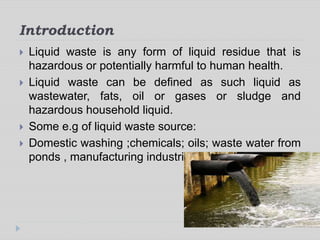What Does Reclaim Waste Do?
Table of ContentsMore About Reclaim WasteThings about Reclaim WasteAbout Reclaim WasteReclaim Waste Things To Know Before You BuyExcitement About Reclaim Waste
Check out the types, occurrences, and kinds of liquid waste. Residential sewage waste refers to the waste and items from a residential septic system. This kind of waste is produced by human beings in residences, schools, and various other structures. This only consists of sewage-disposal tanks that have a drainpipe field. The correct monitoring and disposal of domestic sewer waste need fluid waste to be moved to a sewer treatment plant where the appropriate approaches and devices are related to cleanse and deal with waste.
Industrial waste typically consists of possible risks, such as combustible materials or a blend of liquid and strong waste items, and needs an advanced and comprehensive disposal process. The disposal of industrial waste usually entails the filtering of waste prior to transportation to make sure secure and proper disposal. Hazardous waste is developed from by-products and runoff of industrial processes and manufacturing.
This type of waste can not utilize the exact same sewer monitoring transport or processes as septic or commercial fluids. The hazardous waste administration procedure calls for the evaluation and testing of fluid waste prior to it goes through the disposal procedure (industrial wastewater treatment). Drainage waste is the fluid waste that originates from drainage and excess stormwater in extremely inhabited locations or cities
Runoff waste can cause contamination and flooding if not taken care of effectively. Ensuring appropriate waste administration can stop disasters and lower environmental harm.
The Main Principles Of Reclaim Waste
Get in touch with PROS Providers today to learn more about our waste management and disposal solutions and the correct ways to look after the liquid waste you create.
(https://reclaimwaste1.edublogs.org/2024/11/12/efficient-liquid-waste-removal-and-disposal-your-complete-guide-to-sustainable-waste-management/)This supposed 'wastewater' is not just an essential resource but, after treatment, will be released to our land, rivers or the sea. Made use of water from toilets, showers, bathrooms, cooking area sinks, washings and commercial processes is understood as wastewater.

water utilized to cool equipment or clean plant and equipment). Stormwater, a type of wastewater, is drainage that moves from farming and metropolitan areas such as roofing systems, parks, gardens, roadways, courses and rain gutters into stormwater drains pipes, after rainfall. Stormwater flows unattended straight to local creeks or rivers, ultimately reaching the ocean.
Some Known Details About Reclaim Waste
In Queensland, most wastewater is dealt with at sewer therapy plants. Wastewater is delivered from domestic or industrial websites via a system of sewers and pump stations, called sewerage reticulation, to a sewer therapy plant. City governments build, preserve and run most sewage therapy plants. Operators are certified under the Environmental Management Act 1994 to discharge cured wastewater at an acceptable ecological standard right into rivers.
The Division of Natural Resources suggests regional federal governments about handling, operating and maintaining sewerage systems and treatment plants. In unsewered locations, local federal governments may need householders to install specific or family sewer therapy systems to treat domestic wastewater from bathrooms, kitchens, shower rooms and laundries. The Division of Natural Resources authorises using house systems when they are confirmed to be effective.
In some new communities, treatment of some stormwater to get rid of trash, sand and gravel has click for info actually started using gross toxin catches. Wastewater treatment happens in 4 phases: Removes strong issue.
Wastewater then streams right into huge tanks where solids settle and are eliminated as sludge. Oil and residue are skimmed from the surface. Makes use of small living microorganisms knows as micro-organisms to break down and get rid of remaining dissolved wastes and fine fragments. Micro-organisms and wastes are incorporated in the sludge. Eliminates nitrogen and phosphorus nutrients that might create algal blooms in our rivers and threaten aquatic life.
Our Reclaim Waste Diaries
Nutrient elimination is not available at all sewer treatment plants due to the fact that it needs costly specialised equipment. Clear fluid effluent created after therapy may still include disease-causing micro-organisms - industrial wastewater treatment.

The majority of wastewater flows right into the sewerage system. Under the Act, neighborhood governments carry out approvals and permits for ecologically relevant tasks (Periods) including wastewater launches that might have a local influence.
Rumored Buzz on Reclaim Waste
Otherwise, examples are taken for research laboratory evaluation. Typically several tests are needed to establish the degrees of each of the different toxins such as oils, heavy metals and chemicals in water. Surveillance provides valid info concerning water top quality and can verify that permit problems are being satisfied. The info acquired via monitoring supplies the basis for making water high quality decisions.